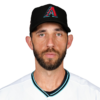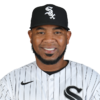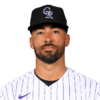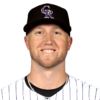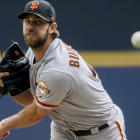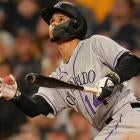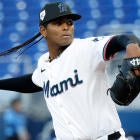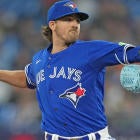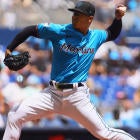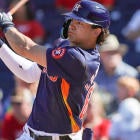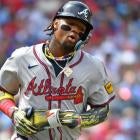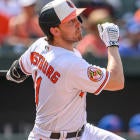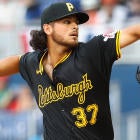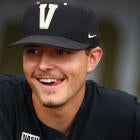Want to get a jump on the competition? Go to the CBS Sports app on your phone, open up "Settings" and sign up for Fantasy alerts to get the latest from our Fantasy baseball team as soon as it's available.
I don't enjoy the bust side of the equation. I like to envision every player as the best possible version of himself. Big, historic seasons are fun. Watching a player or city or the entire baseball world come down from that high ... isn't.
Knowing how to spot a bust, though, could save your butt on Draft Day, particularly in the early rounds when the talent level of everyone is so high that you mostly just don't want to mess things up.
With that in mind, I'm taking some big swings here, tearing down some sacred Fantasy cows. Granted, there's a point when I'd be willing to take them on myself, but at their going rates, it doesn't add up for me.
There's a path to the MVP-level production Javier Baez delivered in 2018 — we know because he took it — but it's a narrow one. I'm not even suggesting any one thing he did was entirely fluky or out of character, but to do them all again, all at once, is a fine line to walk. His approach is so undisciplined that he needs an outlier-type BABIP, like around .345, to make a positive impact in batting average. And while 2018 wasn't the first time he delivered one, living in that range is an unreasonable expectation for at but the best hitters in baseball.
Besides, the last time he did it, he hit only .273 because — guess what? — Baez's 2018 also relied on outlier power production, his 24.3 percent home run-to-fly ball rate placing him eighth among qualifying batters. Maybe that's the new norm for him. Maybe he's one of the best in all the majors at maximizing fly-ball production, but again, it's asking a lot. He needs two superlative performances in two separate areas, and without one, it's a quick spiral from elite to ordinary.
It's a good thing Clayton Kershaw has already carved out a Hall of Fame career for himself because his 30s are shaping up to be a sad footnote. OK, fine, I'm probably overstating it, but ... maybe not. You may have noticed he missed time with a back issue again last year, making it three straight in which he hasn't eclipsed even 180 innings, much less 200, and while it wasn't so bothersome when he was doing Kershaw things like having a 1.70 ERA, the performance is clearly suffering now
I'll borrow liberally from Dr. Mike Tanner of FanGraphs on this matter — him being a doctor and me not — and point out that lost time isn't the only effect of the balky back. Every time Kershaw pitches now, it's through injury, those DL stints only serving to manage it, and the body's way of protecting injuries is to limit the output of other muscles, a phenomenon known as pain inhibition. Kershaw himself may not be able to explain why his average fastball velocity dropped 2 mph last year, but Dr. Tanner has a hypothesis.
Try as the Dodgers might to manage it, it's only going to keep trending this way, and now that we're to the point where he's no longer striking out a batter per inning, things could unravel quickly.
You watch: George Springer is sure to get drafted in the fourth round again. Why? He's a name brand, an early trophy from the Astros rebuild who hit 30 homers that one time. Yeah, once. It's not that he's bad. He scores a bunch of runs batting atop the Astros lineup and offers a pretty high floor now that the strikeouts are under control. But he's routinely drafted for a best-case scenario that he has only once achieved in five years and that's becoming even harder to project for him with the approach of his 30th birthday.
We learned pretty early in his big-league career that Springer wouldn't be the base-stealer he was in the minors, which meant his power would have to carry him. But he puts the ball on the ground too often to tap into that power fully. He's not even hitting line drives, ranking third-worst among qualifiers in that category last year, alongside known batting average liabilities like Khris Davis, Carlos Santana and Brian Dozier. It's why I don't expect any better in 2019. He's exactly who his peripherals say he is, putting much closer to NIcholas Castellanos than Juan Soto in projected H2H production.
Time to face facts: Madison Bumgarner hasn't been the same since crashing his dirt bike early in 2017. Whether it was the damage he did to his shoulder that day or the ungodly number of innings heaped on his arm during the playoff runs of his youth, it's not getting any better. The velocity declined on his cutter again last year. His swinging-strike rate continues to plummet. His 7.6 strikeouts per nine innings last year not only represented his lowest rate since his age-20 season but would have put him in the lower third among qualifying pitchers, had he qualified. And it came with a career-worst walk rate.
He just doesn't have the stuff he used to and is having to eke by without it, being spared in large part by a forgiving home park. Even if he's able to navigate it again in 2019, he won't be able to withstand much more skills erosion without the dam breaking.
For about a four-month span in the middle of last season, Matt Carpenter's elite batted-ball profile — his line-drive, fly-ball and hard-contact rates all ranking among the best of the best — finally yielded the desired result, briefly catapulting him into the NL MVP discussion. But he's 33, so now what? His prime years have been defined by injury and disappointment, and assuming it's all behind him now feels like a stubborn disregard of history. Shoot, 2018 itself ended with him batting .170 with an absurd number of strikeouts in September.
Even if you're a data zealot who holds firm to the idea that conflicting numbers will eventually agree over time, no matter how long the time, the fact is he's running out of time, having now reached an age when injuries are to be expected and a skills decline could hit hard.
Edwin Encarnacion's decline has so far been a gentle one, ensuring that no one who invests in him has been left high and dry even when he doesn't quite live up to the previous year's production. But it may all change in 2019. For the third straight year, his strikeout rate rose and his ISO dropped in 2018, both signs of a slowing bat. He had his lowest walk rate in seven years, a sign that pitchers no longer fear him like they used to, and he swung and missed more than ever before.
At 36, he may still be able to eke out another year or two of this sort of production, but particularly in an environment where power is so easy to come by, he's verging on the reward no longer being worth the risk. Add that he's in a pitcher's park for the first time and with a rebuilding club that doesn't offer much else offensively, and I'm guessing the seven-year streak of 30-plus homers comes to an end, if nothing else.
The Mariners' decision to shed Nelson Cruz, Robinson Cano and Jean Segura this offseason leaves Mitch Haniger on Lonely Island, where he has to sustain himself during a period of non-contention, and it's not clear he's capable of doing that. Ask yourself: What is an outfielder who hits .285 with 26 homers worth in today's power-laden environment? What about if his .336 BABIP normalizes, leaving him with closer to a .260 batting average? Seems like he's verging on Hunter Renfroe's and Trey Mancini's domain in that scenario — i.e., nothing special.
Certainly Haniger's production was special in 2018, but largely because of the 90 runs and 93 RBI, which were products of the supporting cast he no longer has. Without them, he's Joe Guy — maybe a little better in points leagues because of the walks, but certainly not worth the price of admission.
If you're like me, you entered 2018 thinking David Peralta wasn't even capable of hitting 30 home runs. Not a guy coming off a 14-homer season with a career high of only 17, so something must have changed for him to rise to that level. Indeed, one of these things is not like the others:
Year | Hard contact rate (via FanGraphs) |
2014 | 30.4 |
2015 | 35.4 |
2016 | 34.6 |
2017 | 31.8 |
2018 | 48.6 |
Yup, he started hitting the ball crazy hard. How hard? Second-hardest in all of baseball by this metric, as it turns out, which explains how he was able to double his home run-to-fly ball rate. The question is whether he can do it again, and as a general rule, I don't trust in some new trick a well established ballplayer picks up at age 30. That's especially true when it comes to how hard he hits the ball, which doesn't have as great a correlation with success as, say, fly-ball rate. Notice nothing changed there:
Year | Fly-ball rate (via FanGraphs) |
2014 | 30.9 |
2015 | 26.6 |
2016 | 28.5 |
2017 | 26.5 |
2018 | 29.2 |
In fact, Peralta had the 21st-lowest fly-ball rate in all of baseball, which means if his quality of contact suffers, the correction could be steep. Continuing the power surge means asking him to do something better than almost every other player again. Seems unlikely, no?
This pick is unusual in that Miguel Andujar's numbers seem pretty honest. He hardly strikes out and had a normal BABIP, so why wouldn't he do it again? It's more a matter of whether he'll get the chance, which sounds crazy after he nearly won Rookie of the Year and obviously had a positive impact on the lineup. But his defense ... oh dear. How bad is it? So bad that FanGraphs give him a minus-14 Def score, lowest among qualifying third basemen. The next lowest was minus-5.
The Yankees have focused this offseason on bringing in infielders to fill in for Didi Gregorius, but Gregorius, who had Tommy John surgery in October, isn't going to miss more than half of 2019. And while Troy Tulowitzki probably doesn't deserve to play much these days, DJ LeMahieu certainly does. So when everybody's healthy, the Yankees will need to reassess whether Andujar's bat is really worth his glove. True, they could potentially play both Aaron Judge and Giancarlo Stanton in the outfield, freeing up DH for Andujar, or even move Luke Voit off first base, but there are no guarantees here. Shoot, it's no guarantee Andujar doesn't become part of some platoon before then, with the Yankees swapping out offense for defense as they see fit.
An ill-timed slump or series of defensive miscues could be catastrophic for his playing time, so while I think Andujar is a perfectly fine option if he plays, I'd prefer to see him go to someone else on Draft Day.
If we could trust that Mike Foltynewicz's 9.9 strikeouts per nine innings were legit, it'd be easier to trust in the rest. But he had a below-average swinging strike rate and is lacking a true swing-and-miss offering (not to mention anything resembling a changeup). He did a pretty good job of getting ahead of hitters but ultimately walked 3.3 per nine innings, so it's not like you can trust him to put the ball where he wants. And to top it off, he had the 10th-lowest home run-to-fly ball rate among qualifiers, which means he probably should have given up more home runs than he did.
I just don't see it all coming together so perfectly again. His FIP suggests he should have had a 3.37 ERA, and his xFIP, which better accounts for the home run luck, suggests it should have been 3.77. And remember: That's assuming he maintains the same strikeout rate, which we've already deemed unlikely.
Between Ryan McMahon and Garrett Hampson, a bottleneck is already forming for Rockies infield prospects and can only get worse once Brendan Rodgers, Colton Welker and Tyler Nevin prove ready. So it's put up or shut up time for Ian Desmond, who's only still around because the Rockies were foolish enough to sign him to a big-money deal two years ago.
He's not a complete zero to Fantasy owners given his willingness to run a bit, but only four of his 18 home runs came in the second half last year — a necessary correction given that he's the most extreme ground-ball hitter in the game today. If that willingness to steal bases proves to be all he has left at age 33, he's not long for this world, so I wouldn't target him with the expectation of another 20-20 campaign.
Kyle Freeland had an astonishing 8.4 WAR last year, a mark that some Hall of Famers would be proud to call theirs, so in a way it feels reckless to dismiss him so, especially since nobody's exactly drafting him as an ace. But just because he scaled the statistical tight rope for all of 2018 doesn't mean he can do it again.
Nothing about the performance made sense given that nothing in his profile stands out. He's a below-average strikeout pitcher and a below-average control pitcher. He's below-average at getting ahead of the count with no better than an average ground-ball rate. He was great at stranding runners, but was it skill or just the way things turned out? Given his home venue's history of punishing mistakes and eating pitchers like him for breakfast — or shoot, eating all pitchers for breakfast, apart from the odd Ubaldo Jimenez or German Marquez season —there's not a case I can see for giving him the benefit of the doubt.













